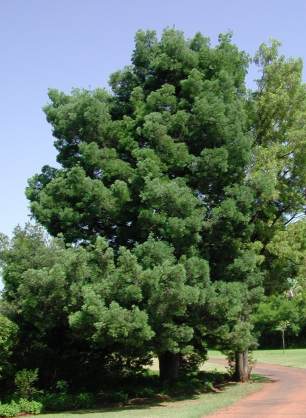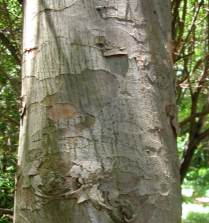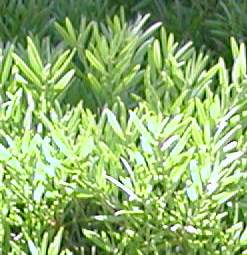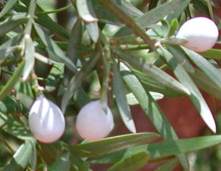Afrocarpus falcatus
Afrocarpus falcatus (Thunb.) C.N.Page (= Podocarpus falcatus (Thunb.) R.Br. ex Mirb.)
Family: Podocarpaceae
Common names: Outeniqua yellowwood (English), Outeniekwageelhout, kalander (Afrikaans), umkhoba, umgeya (Xhosa), mogôbagôba (Northern Sotho), umsonti (Zulu).
SA Tree No: 16
Introduction
This fast-growing, majestic yellowwood with its elegant shape is certainly a tree for all seasons and all gardens. It is an excellent container plant and can also be decorated and used as an indoor Christmas tree.
The new flush of bluish-grey leaves in spring contrast beautifully against the older, dark green, mature leaves. The plant belongs to the Gymnospermae division of seed-bearing plants, differing from Angiospermae by the fact that the ovules are not enclosed in carpels-they are naked. Podocarpaceae is one of only seven Gymnosperm families found in South Africa, and this tree is protected.

Description
Description
This tall, evergreen tree can reach a height of 45 m in nature but luckily never reaching that great height in garden cultivation.

The bark is interesting, being smooth and ridged on younger stems and peeling off in flakes on the older trees.
The leaves are arranged spirally, with parallel veins and smooth margins. The leaf tip is sharply pointed.

Male and female cones occur on different trees. The large, yellow, fleshy fruits take a year to ripen and hang from the branches in clusters.
Conservation Status
Status
Least Concern (LC), Afrocarpus falcatus is not threatened.
Distribution and habitat
Distribution description
This tree occurs from the southern Western Cape, through the Eastern Cape and KwaZulu-Natal, and northwards to Mpumalanga and Limpopo and also eastwards to Mozambique.

Derivation of name and historical aspects
History
Afro = of Africa, and karpos = fruit (Greek); falcatus = sickle-shaped (Latin) alludes to the leaves. This species was previously known as Podocarpus falcatus, and although some botanists did not recognise the name change, molecular analysis supports it.
Ecology
Ecology
Ripe fruits are eaten by bats, bushpigs, fruit-eating birds (Cape parrots, purple-crested, Knysna and Ross's louries, Rameron, African green and Delagorgue's pigeons). The large, dense crown is often a roosting and nesting site for various birds.
Uses
Use
The wood is used extensively for furniture, roof beams, floorboards, door and window frames and boat building. Some of the famous yellowwood antiques seen throughout South Africa were made from the wood of this specific tree. The straight stems of these trees were once used for the topmasts of ships. The bark is used for tanning leather. Afrocarpus falcatus could make an ideal indigenous substitute for the exotic pine trees currently being used in plantations; trials done at a forest station at Magoebaskloof showed that the yield is similar, with the growth rate and quality of the wood comparing favourably to that of commercial pine. The ripe fruit is edible and very resinous. The sap is used as a remedy for chest complaints.
Growing Afrocarpus falcatus
Grow
Remove the fleshy part of the fruit to expose the seed. This process is very important as the fleshy part contains an inhibitor, which seems to suppress germination. The fresh seed can be sown directly into black nursery bags or into deep seed trays using a mixture of well-rotted compost and washed sand (1:1). The seed must be pushed and bedded into the mixture and covered with a light layer of soil. The mixture must stay moist at all times. Some of the seed may take up to six months to germinate, so be patient. Seedlings can be pricked out at a height of 50-80 mm and planted into bags or pots. Care must be taken not to damage the taproot as this may slow the initial growth rate of the plant.
References
- Barker, N.P., Muller, E.M. & Mill, R.R. 2004. A yellowwood by any other name: molecular systematics and the taxonomy of Podocarpus and the Podocarpaceae in southern Africa. South African Journal of Science. 100:629-632.
- Coates Palgrave, K. 1988. Trees of southern Africa, 2nd Edn. Struik Publishers, Cape Town, Johannesburg.
- Venter, F. & Venter, J. 1996. Making the most of indigenous trees. Briza Publications, Pretoria.
- Pooley, E. 1993. The complete field guide to trees of Natal, Zululand and Transkei. Natal Flora Publication Trust, Durban.
- Leistner, O.A., Smith, G.F. & Glen, H.F. 1995. Notes on Podocarpus in southern Africa and Madagascar (Podocarpaceae). Bothalia 25: 233-23
Credits
Nick Klapwijk
Pretoria National Botanical Garden
November 2002
updated April 2020
Plant Attributes:
Plant Type: Tree
SA Distribution: Eastern Cape, KwaZulu-Natal, Limpopo, Mpumalanga, Western Cape
Soil type: Sandy, Loam
Flowering season:
PH: Neutral
Flower colour:
Aspect: Full Sun, Morning Sun (Semi Shade), Afternoon Sun (Semi Shade)
Gardening skill: Easy
Special Features:
Horticultural zones











Rate this article
Article well written and informative
Rate this plant
Is this an interesting plant?
Login to add your Comment
Back to topNot registered yet? Click here to register.